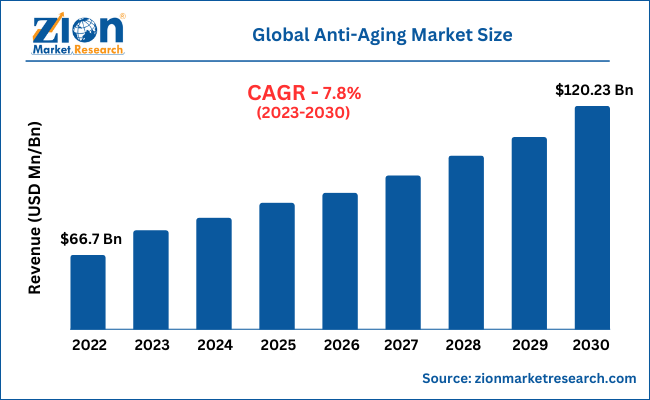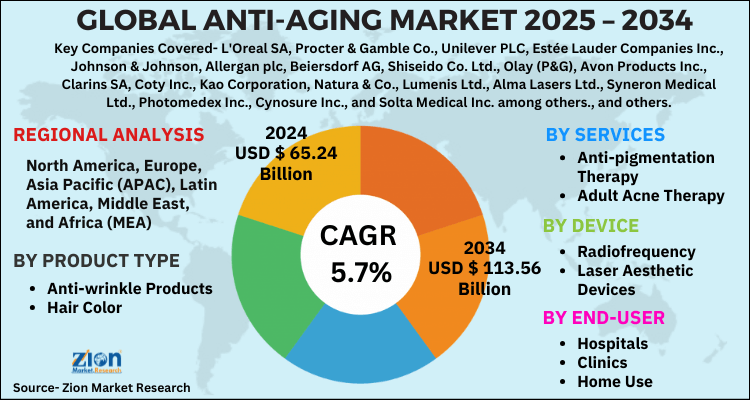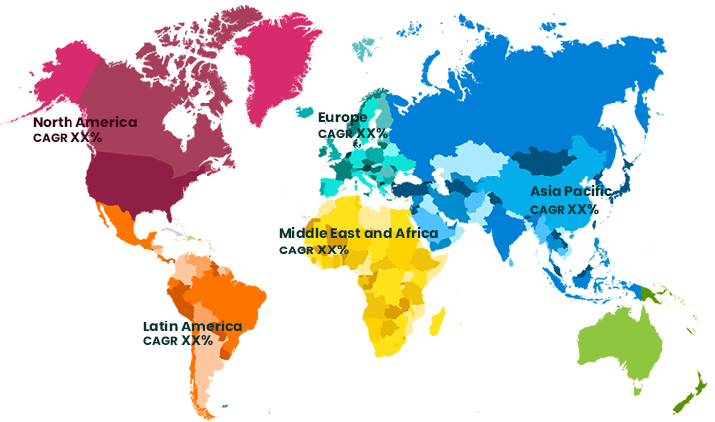Global Anti-Aging Market Size, Share, Growth Analysis Report - Forecast 2034

Anti-Aging Market By Product Type (Anti-wrinkle Products, Hair Color, UV Absorbers, Anti-stretch Mark Products), By Services (Anti-pigmentation Therapy, Adult Acne Therapy, Hair Restoration, Breast Augmentation, Liposuction, Others), By Device (Radiofrequency, Laser Aesthetic Devices, Microdermabrasion Devices, Others), By End-user (Hospitals, Clinics, Home Use, Dermatology Centers), By Distribution Channel (Supermarkets/Hypermarkets, Specialty Stores, Pharmacies, Online Retail), and By Region: Global and Regional Industry Overview, Market Intelligence, Comprehensive Analysis, Historical Data, and Forecasts 2025 - 2034
| Market Size in 2024 | Market Forecast in 2034 | CAGR (in %) | Base Year |
|---|---|---|---|
| USD 65.24 Billion | USD 113.56 Billion | 5.7% | 2024 |
Anti-Aging Market: Industry Perspective
The global anti-aging market size was worth around USD 65.24 Billion in 2024 and is predicted to grow to around USD 113.56 Billion by 2034 with a compound annual growth rate (CAGR) of roughly 5.7% between 2025 and 2034. The report analyzes the global anti-aging market's drivers, restraints/challenges, and the effect they have on the demands during the projection period. In addition, the report explores emerging opportunities in the anti-aging industry.
The market report offers quantitative and qualitative insights into the key drivers, opportunities, constraints, and challenges impacting the global anti-aging market industry.
Anti-Aging Market: Overview
Skin aging is a complex biological process influenced by a combination of endogenous/intrinsic and exogenous/extrinsic factors. It is caused by factors such as age, exposure to ultraviolet rays (UV), pollution, lifestyle-related factors (smoking, restricted sleep, diet & nutrition, harsh soaps, stress & depression), and repeated facial expressions.
The primary noticeable signs of skin aging are fine lines and wrinkles. Anti-aging cosmetics can be divided into three groups depending on their functions, namely moisturizing, antioxidant, and biological activity. Treatments for anti-aging comprise numerous approaches, including cosmetological care (daily skin care, sun protection, aesthetic noninvasive procedures), topical agents (antioxidants, cell regulators), and invasive procedures (chemical peelings, visible light devices, intense pulsed light, radiofrequency, injectable skin biostimulation, and rejuvenation).
Key Insights
- As per the analysis shared by our research analyst, the global anti-aging market is estimated to grow annually at a CAGR of around 5.7% over the forecast period (2025-2034).
- Regarding revenue, the global anti-aging market size was valued at around USD 65.24 Billion in 2024 and is projected to reach USD 113.56 Billion by 2034.
- The anti-aging market is projected to grow at a significant rate due to Increasing aging population and rising consumer focus on aesthetics and wellness are major drivers. Advances in skincare and cosmetic technologies also play a role.
- Based on Product Type, the Anti-wrinkle Products segment is expected to lead the global market.
- On the basis of Services, the Anti-pigmentation Therapy segment is growing at a high rate and will continue to dominate the global market.
- Based on the Device, the Radiofrequency segment is projected to swipe the largest market share.
- By End-user, the Hospitals segment is expected to dominate the global market.
- In terms of Distribution Channel, the Supermarkets/Hypermarkets segment is anticipated to command the largest market share.
- Based on region, North America is predicted to dominate the global market during the forecast period.
Anti-Aging Market: Growth Factors
Rise in disposable income and the rising aging population drive the growth of the industry
The global anti-aging market is predicted to surge rapidly due to the increasing aging population, desire for a youthful appearance, advancements in technology & product innovation, increasing disposable income & healthcare expenditure, and rising awareness and acceptance of anti-aging products and services. As people live longer and healthier lives, there is a growing demand for products and services that help them maintain a youthful appearance and improve their quality of life. Technological advancements and product innovations have made it possible to develop more effective and safer anti-aging solutions. Additionally, rising disposable income and healthcare expenditure have made anti-aging products and services more affordable and accessible to a wider population.
Anti-Aging Market Opportunities
Surge in demand for organic and natural products creates ample opportunities for the industry
Opportunities in the anti-aging market include the development of personalized & targeted anti-aging solutions, increasing demand for non-invasive procedures, and the growing popularity of organic & natural products. Personalized and targeted solutions can cater to the specific needs and preferences of individuals, providing more effective and personalized care. Non-invasive procedures, such as injectables and laser treatments, are gaining popularity as they offer minimal downtime and reduced risk compared to traditional surgical procedures.
The trend towards natural and organic products is driven by consumers' preference for safer and healthier options, providing an opportunity for companies to develop more natural and organic anti-aging products. Overall, the anti-aging market offers significant opportunities for companies to develop innovative products and services that cater to the evolving needs and preferences of consumers.
Anti-Aging Market: Restraints
Prevalence of misleading advertising and false claims from companies might hinder the growth of the industry
One of the biggest restraints of the anti-aging industry is the lack of regulation and standardization. With so many products and procedures available, it can be difficult for consumers to know what is safe and effective. Additionally, the lack of regulation can lead to false claims and misleading advertising, which can harm consumers and damage the credibility of the industry as a whole. This has led to a lack of trust from consumers, which can make it difficult for legitimate companies to gain traction in the market.
Anti-Aging Market: Challenges
Extortionate cost of premium products might act as a challenge for the anti-aging industry
Another challenge of the anti-aging market is the high cost of many products and procedures. While some consumers may be willing to pay a premium for effective anti-aging treatments, the high cost can make it inaccessible for many people. This can limit the market and prevent companies from reaching a wider audience. Additionally, the high cost can lead to skepticism from consumers, who may wonder if the benefits are worth the price.
Anti-Aging Market: Segment Analysis
The global anti-aging market is segmented based on age geographic, product, services, device, and region.
Based on age geographic, the market is bifurcated into baby boomers, generation X, and generation Y. The generation X segment held the largest market share in 2022 and is further predicted to grow at a remarkable CAGR during the forecast period. Generation X, typically defined as individuals born between the mid-1960s and early 1980s, is now reaching middle age and becoming increasingly interested in products and procedures that can help them maintain a youthful appearance and feel healthy as they age. As this segment continues to age, the demand for anti-aging products and procedures is expected to grow, creating opportunities for companies to develop and market innovative solutions to meet their needs.
Based on product, the market is segmented into Botox, anti-wrinkle products, anti-stretch mark products, and others. The anti-wrinkle segment held the dominating market share in 2022 and is further expected to grow at a notable CAGR during the forecast period. Anti-wrinkle products include creams, serums, and masks that are designed to reduce the appearance of wrinkles and fine lines. The growth of this segment is being driven by increased consumer demand for non-invasive and affordable solutions to combat the signs of aging. In addition, advancements in technology have allowed for the development of more effective anti-wrinkle products, such as those containing retinol, hyaluronic acid, and collagen.
Based on services, the market is bifurcated into anti-pigmentation therapy, anti-adult acne therapy, and breast augmentation.
Based on device, the market is segmented into microdermabrasion, laser aesthetics, anti-cellulite treatment, and anti-aging radio frequency devices. The microdermabrasion segment held the dominating market share in 2022 and is further projected to grow at a promising CAGR during the forecast period. The microdermabrasion segment of the anti-aging market is experiencing growth due to its effectiveness in improving skin texture and reducing the appearance of fine lines and wrinkles. Microdermabrasion is a non-invasive procedure that uses a device to exfoliate the outermost layer of skin, stimulating cell turnover and collagen production. The growth of this segment is being driven by increasing consumer interest in non-surgical anti-aging solutions that are both effective and affordable. In addition, advancements in technology have allowed for the development of more advanced microdermabrasion devices that provide better results and are more comfortable for patients.
Anti-Aging Market: Report Scope
| Report Attributes | Report Details |
|---|---|
| Report Name | Anti-Aging Market |
| Market Size in 2024 | USD 65.24 Billion |
| Market Forecast in 2034 | USD 113.56 Billion |
| Growth Rate | CAGR of 5.7% |
| Number of Pages | PagesNO |
| Key Companies Covered | L'Oreal SA, Procter & Gamble Co., Unilever PLC, Estée Lauder Companies Inc., Johnson & Johnson, Allergan plc, Beiersdorf AG, Shiseido Co. Ltd., Olay (P&G), Avon Products Inc., Clarins SA, Coty Inc., Kao Corporation, Natura & Co., Lumenis Ltd., Alma Lasers Ltd., Syneron Medical Ltd., Photomedex Inc., Cynosure Inc., and Solta Medical Inc. among others., and others. |
| Segments Covered | By Product Type, By Services, By Device, By End-user, By Distribution Channel, and By Region |
| Regions Covered | North America, Europe, Asia Pacific (APAC), Latin America, The Middle East and Africa (MEA) |
| Base Year | 2024 |
| Historical Year | 2020 to 2024 |
| Forecast Year | 2025 to 2034 |
| Customization Scope | Avail customized purchase options to meet your exact research needs. Request For Customization |
Recent Developments
- In March 2021, L'Oréal announced the launch of a new skin analysis tool called Skin Consulting. The tool uses artificial intelligence to analyze the user's skin and provide personalized recommendations for skincare products and routines. This technology represents a major step forward in the development of personalized anti-aging solutions.
- In December 2020, Allergan announced the FDA approval of its Juvéderm Voluma XC injectable gel for the chin. This product is designed to add volume to the chin and jawline, addressing concerns associated with aging in this area. This approval expands Allergan's product offerings in the anti-aging market and provides consumers with a non-surgical alternative for addressing the signs of aging in the lower face.
Anti-Aging Market: Regional Analysis
North America to lead the global market during the forecast period
Based on region, the North American region held the largest anti-aging market share in 2022 and is further predicted to grow rapidly at an exponential CAGR during the forecast period. The anti-aging market in North America is experiencing significant growth due to several factors, including an aging population, increased consumer awareness of the benefits of anti-aging products & procedures, and a growing demand for non-invasive solutions.
The growth of the market in North America is being driven by the United States, which has the highest demand for anti-aging products and procedures in the region. The market is also benefiting from the presence of key players in the region, who are readily investing in research and development to develop innovative anti-aging solutions.
Anti-Aging Market: Competitive Analysis
The report provides a company market share analysis to give a broader overview of the key market players. In addition, the report also covers key strategic developments of the market, including acquisitions & mergers, new product launches, agreements, partnerships, collaborations & joint ventures, research & development, and regional expansion of major participants involved in the anti-aging market on a global and regional basis.
The global anti-aging market is dominated by players like:
- L'Oreal SA
- Procter & Gamble Co.
- Unilever PLC
- Estée Lauder Companies Inc.
- Johnson & Johnson
- Allergan plc
- Beiersdorf AG
- Shiseido Co. Ltd.
- Olay (P&G)
- Avon Products Inc.
- Clarins SA
- Coty Inc.
- Kao Corporation
- Natura & Co.
- Lumenis Ltd.
- Alma Lasers Ltd.
- Syneron Medical Ltd.
- Photomedex Inc.
- Cynosure Inc.
- and Solta Medical Inc. among others.
The global anti-aging market is segmented as follows;
By Product Type
- Anti-wrinkle Products
- Hair Color
- UV Absorbers
- Anti-stretch Mark Products
By Services
- Anti-pigmentation Therapy
- Adult Acne Therapy
- Hair Restoration
- Breast Augmentation
- Liposuction
- Others
By Device
- Radiofrequency
- Laser Aesthetic Devices
- Microdermabrasion Devices
- Others
By End-user
- Hospitals
- Clinics
- Home Use
- Dermatology Centers
By Distribution Channel
- Supermarkets/Hypermarkets
- Specialty Stores
- Pharmacies
- Online Retail
By Region
- North America
- The U.S.
- Canada
- Mexico
- Europe
- France
- The UK
- Spain
- Germany
- Italy
- Rest of Europe
- Asia Pacific
- China
- Japan
- India
- Australia
- South Korea
- Rest of Asia Pacific
- The Middle East & Africa
- Saudi Arabia
- UAE
- Egypt
- Kuwait
- South Africa
- Rest of the Middle East & Africa
- Latin America
- Brazil
- Argentina
- Rest of Latin America
Table Of Content
Methodology
FrequentlyAsked Questions
The global anti-aging market is expected to grow due to Increasing aging population and rising consumer focus on aesthetics and wellness are major drivers. Advances in skincare and cosmetic technologies also play a role.
According to a study, the global anti-aging market size was worth around USD 65.24 Billion in 2024 and is expected to reach USD 113.56 Billion by 2034.
The global anti-aging market is expected to grow at a CAGR of 5.7% during the forecast period.
North America is expected to dominate the anti-aging market over the forecast period.
Leading players in the global anti-aging market include L'Oreal SA, Procter & Gamble Co., Unilever PLC, Estée Lauder Companies Inc., Johnson & Johnson, Allergan plc, Beiersdorf AG, Shiseido Co. Ltd., Olay (P&G), Avon Products Inc., Clarins SA, Coty Inc., Kao Corporation, Natura & Co., Lumenis Ltd., Alma Lasers Ltd., Syneron Medical Ltd., Photomedex Inc., Cynosure Inc., and Solta Medical Inc. among others., among others.
The report explores crucial aspects of the anti-aging market, including a detailed discussion of existing growth factors and restraints, while also examining future growth opportunities and challenges that impact the market.
RelatedNews
HappyClients
Zion Market Research
Tel: +1 (302) 444-0166
USA/Canada Toll Free No.+1 (855) 465-4651
3rd Floor,
Mrunal Paradise, Opp Maharaja Hotel,
Pimple Gurav, Pune 411061,
Maharashtra, India
Phone No +91 7768 006 007, +91 7768 006 008
US OFFICE NO +1 (302) 444-0166
US/CAN TOLL FREE +1 (855) 465-4651
Email: sales@zionmarketresearch.com
We have secured system to process your transaction.
Our support available to help you 24 hours a day, five days a week.
Monday - Friday: 9AM - 6PM
Saturday - Sunday: Closed







